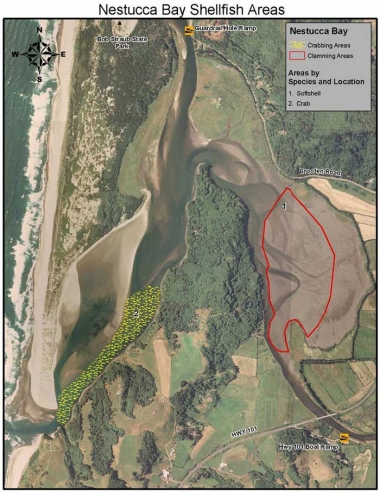
Where to crab & clam in Nestucca Bay
You'll find crab areas and softshell clamming opportunities in the southern part of the bay.

Areas
Area 1
Can be reached by either boat or beach access. Beach access is obtained from Brooten Rd., approximately 1 mile south of Pacific City. Softshell clams can be found throughout this area. These mud flats can have soft spots where walking may be difficult. For digging, using a shovel or clam gun would be best.
Area 2
Will require a boat for crabbing. Pots may be set anywhere within this area.
Boat Launches
Boat launches in Nestucca Bay can be found at the following locations:
Fisher Landing/Guardrail Hole
Approximately 1 mile south of Pacific City, off Brooten Rd.
Pacific City Ramp
From Pacific Ave. in Pacific City, turn south on Sunset Dr. toward Bob Straub State Park (not shown on map).
Little Nestucca/101 Ramp
At approximately mile post 92 on Hwy 101, turn on to Meda Loop Rd, proceed ½ mile, then turn north at first curve.
Information provided is a result of past ODFW surveys, recent spot checks, and input from local residents. The purpose of this map is to provide the user with information and locations of recreational shellfish areas where the most likelihood of success may be found by species. Clam species identified within a particular area represent the most abundant found; other species may be present or may exist in areas not identified on the map. This is to be used as a reference as sandbars, clam beds, and species composition can shift over time. Always use caution when boating/crabbing in the lower bay as swift currents during tidal exchanges can occur, and result in loss of gear or cause boat to be pulled out to sea if mechanical problems arise.
Header photo by the US Fish and Wildlife Service


